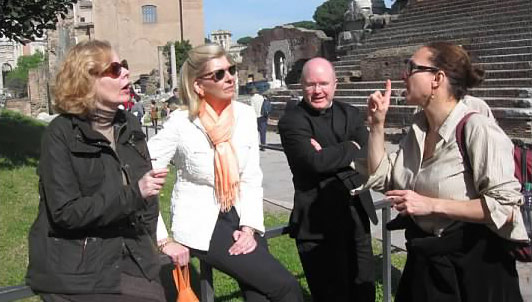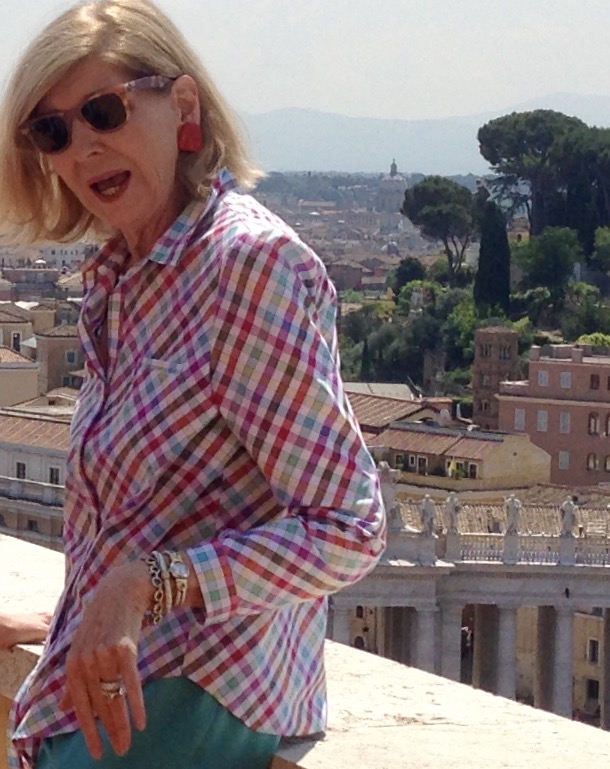W.B. Yeats’s “Beautiful Lofty Things” – a posthumous love letter of sorts to some outsized figures who shaped the poet’s life – ends with wistful longing for “All the Olympians, a thing never known again.” With those eight words, the bard summons a haunting constant of our existence: the knowledge that some human lives are so colossal and rich that they impoverish the whole earth upon their leaving it.
Kate O’Beirne, who died this week and whose funeral was yesterday at the Arlington Diocese’s St. Thomas More Cathedral, was just such a visitor from the Pantheon. She was a massive one-woman media presence, variously, the Washington editor of National Review; a deputy assistant secretary in the Reagan administration; a daunting conservative presence on the CNN show “Capital Gang”; author of a popular column called “Bread and Circuses,” also for National Review; a vice-president of the Heritage Foundation; and president of National Review Institute.
And those were just some day jobs. She was married to James O’Beirne, an officer in the U.S. Army whose career likewise defies short summary; and mother of Philip O’Beirne and John O’Beirne, ditto. Nothing about her was common; everything about her was rare.
There was, for starters, her striking physical presence – the regal height, the lovely visage all but demanding portraiture, the effervescent fashion sense that made encounters with her into mini-adventures in elegance. Unforgettable though they were and are, though, these were mere outward and material symbols of what was immaterial and extraordinary within.
She was a wife and mother who was also a mentor to hundreds, and a sister to untold numbers, especially in the clergy. She was an unapologetic, happy daughter of Rome during years when apologies and unhappiness were thick on the cobblestones. Kate loved the Church, and the Church loved Kate. Her conviction of the truth of the faith tied her every bon mot to bedrock.
Irreverence in the service of reverence: as Chesterton could have explained, the paradox that was Kate’s work in the world was really no paradox at all.
As the multiplication of tributes since her death have illustrated, including this one at her former home, National Review. The lady could also be a scamp. She reveled in tweaking her many friends in religious life – as well as in life, period. And to great effect; Kate could make Cardinals laugh in church.

Among the humorous stories shared about her, one favorite made its way into her funeral homily by Fr. Paul Scalia. As her colleague Ramesh Ponnuru explained it, “Leaving last year’s National Catholic Prayer Breakfast – one of her final public outings – she saw a favorite priest tipping a bellman, she thought inadequately. She gently corrected him: ‘Father, you took a vow of poverty, not him.’”
Tales like that explain why so much has been made of Kate’s “feistiness” in the outpouring of tributes since her death last week. Even so, pluck was the least of it. Kate was not only a wordsmith, but a wit of the very first order. She could think faster than other mortals, and she could out-quip anyone with a mischievousness that was practically supernatural. If Shakespeare had allowed Tatiana to run off with Puck, Kate could have been the result.
The dazzle of Kate as Gestalt risks obscuring the rigor of Kate as Verstand. To offer just one example, her book Women Who Make the World Worse, published a dozen years ago, not only foresees current seismic faults. It could just as well be republished verbatim today, so prescient is its analysis, and so apropos of the cultural wreckage even more visible now than it was a dozen years ago.
Consider this opening from Chapter Four: “We parents of boys have meekly allowed gender warriors to treat our sons like unindicted co-conspirators in history’s gender crimes, while parents of girls permit their daughters to be patronized as helpless victims of a phantom, crippling sex bias in America’s schools.” Seldom, if ever, have the manifold delusions concerning gender and sex in our time been captured so well in a single sentence.
Unlike most of those now mourning the loss of this great Kate, I didn’t make her acquaintance until her last years. But the fact that I was late to that party didn’t stop her from treating me (and a few thousand other people) as if we’d been artificially separated at birth, with an enormous amount of time and fun to make up. A year ago, along with her dearest of friends, Ann Corkery, Kate and her husband Jim threw one of her many storied soirees at the O’Beirne home, this one on behalf of my latest book.
It turned out to be her final star turn in front of an audience of size. Following months of suffering, about which most of her many friends knew nothing, a crowd of hundreds surrounded Kate one last time yesterday during her funeral.
The Corkery-O’Beirne partnership presided most famously over the transformative trip they led to Rome every summer for a handful of journalists. One souvenir from the 2015 excursion is a photo I took of Kate on the rooftop of the Apostolic Palace. She’s leaning against a marble ledge, clad elegantly in teal slacks, a white blouse with jewel-toned stripes, wrist bangles galore, and signature coral-frame sunglasses. She looks more like a model entering a casting call for La Dolce Vita than like a consigliere who was just in conference with members of the Curia, some of Rome’s leading journalists, and an archbishop or two – all before lunch.
Behind her in the photo there’s a cornflower Roman sky; below, at the bottom of the frame, statues of the saints atop the Colonnade outside St. Peter’s stand guard. Suspended for that second between heaven and earth, Kate looks radiant and relaxed, marveling at what’s above and below, this-worldly and that-worldly at once.
And so she should be remembered. In the end, and pace Yeats, it is our faith that we’ll come to know this Olympian again, after all.















